Solo for Sliding Trombone
Andrew Digby: Performing the Solo for Sliding Trombone
John Cage, Solo for Sliding Trombone (page 181)
Andrew Digby
Introduction
Cage’s Solo for Sliding Trombone with its barks, scratches and underwater trombone bubblings, has our impassioned vote so far for this year’s most artless concert piece[.] (Paul Hertelendy, Oakland Tribune)
John Cage’s Solo for Sliding Trombone was a tasteless inventory of all available trombone sounds, visceral and otherwise, including the gurgling of the instrument, with its bell under water. (Carl Cunningham San Francisco Chronicle, cited in Baker, [1974])
These two dismissive reviews of Stuart Dempster’s 1966 performance of Cage’s Solo for Sliding Trombone give little indication of the relative popularity that the piece would achieve within the solo trombone repertoire in the subsequent 60 years. Indeed, of all of the instrumental parts of the Concert, the Solo for Sliding Trombone seems to have been performed the most widely as a solo piece in its own right. It is also the most widely recorded: four commercial recordings exist of the Solo for Sliding Trombone, performed by James Fulkerson (performed with Fontana Mix (1958)) (on Music for Trombone, 1992), Bob Gillespie (on A Walk on the Wild Side: Perpetual Horizons, 2001), Christian Lindberg (on The Solitary Trombone, 1989), and Mike Svoboda (in a version for eight multi-tracked parts) (Da Lontano, 2012).
The Solo for Sliding Trombone is arguably the most theatrical of the Solos, and is rich both in the range of techniques that Cage asks for (some of which are unique to this part and had never been used before), and the highly choreographic movements that some of the techniques require. It is also the densest of all of the parts in terms of the number of sounds notated per page (an average of 19). The Solo could be situated alongside Berio’s Sequenza V (1966) for solo trombone as a theatrical work for trombone soloist, and in fact Dempster performed the Solo at the premiere of the Berio at the San Francisco Tape Music Centre alongside Robert Erickson’s Ricercare a 5 for five trombones (1966), and Pauline Oliveros’s Theatre Piece for trombone (1965).
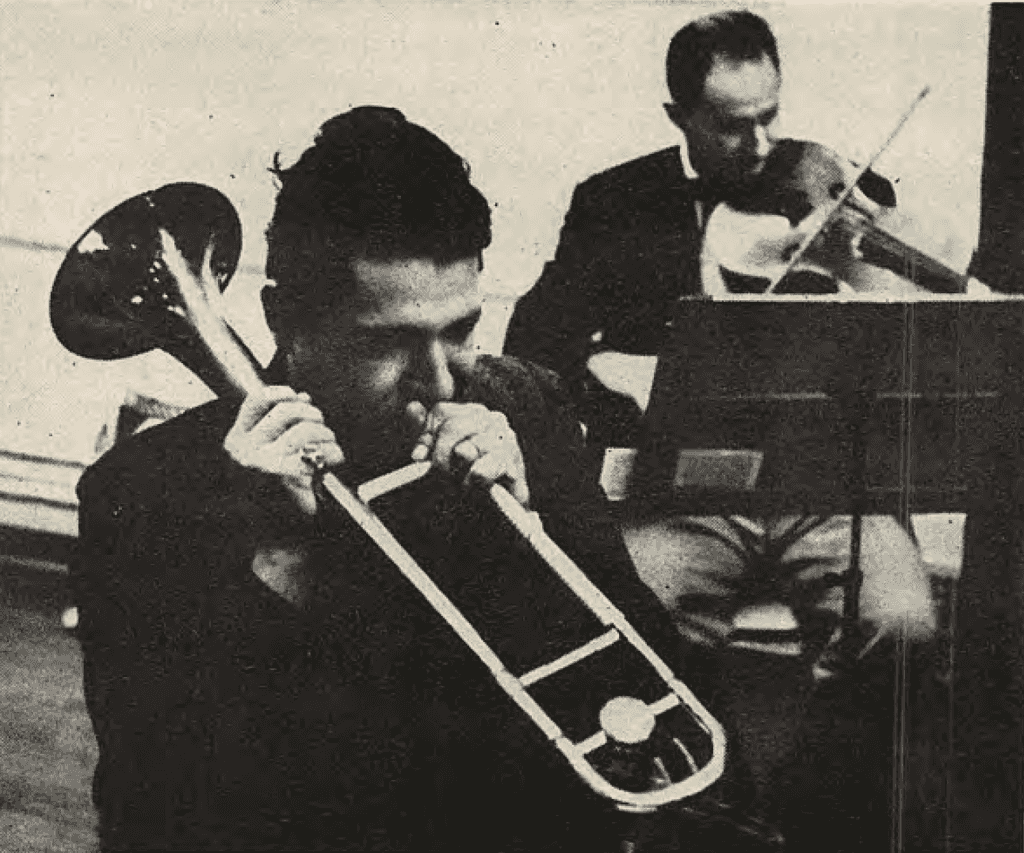
Cage attributed the diversity of the part to its first performer, jazz trombonist Frank Rehak (pictured here performing in the premiere of the Concert), writing in a letter to Dempster that Rehak was ‘excellent and that’s why the trombone [part] is interesting’ (24 July 1974 (source: John Cage Collection)). Rehak seems to have played an important role in generating the wide array of sounds in the part. Dempster writes that Rehak ‘distinguished himself as a fine jazz trombonist playing with many of the great bands of the ‘40s, ‘50s, and ‘60s. He also had a background of classical training as a cellist and pianist, and this combination of classical and jazz background made him an ideal person for Cage to work with. Cage felt that Rehak’s special talents were what made the trombone part such a good one’ (Dempster, 1979, 96–97).
Rehak himself describes Cage visiting him in his apartment to discuss the instrument’s various technical possibilities:
I remember that we spent a long time with the instrument, taking it apart, playing without slide, without mouthpiece, adding various mutes, glass on the slide section, minus tuning slide, with spit valve open, and any other possibilities of producing a sound by either inhaling or exhaling air through a piece of metal tubing. We also discussed double stops, circular breathing, playing without moving slides, and on and on. […] From these ideas we gathered together, we put forth a part that would be playable as a solo or in conjunction with a group of other players. (Cited in Dempster, 1979, 96–97).
Clefs
Although Cage doesn’t provide a clef for the Solo for Sliding Trombone, the instruction for the ‘spit valve’ (water key) to be ‘used only on overtone series of B flat’ is indicative that the part is written in the bass clef.
Mutes
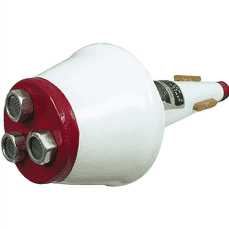

Cage specifies five mutes in the Solo for Sliding Trombone. In the instructions, he writes: ‘#2 is a plunger to be sometimes opened and closed during the tone production. #4 produces a buzz. #5 is a hat. #1 and #3 may be freely chosen by the player.’ The plunger mute is a standard model of mute that should be familiar to most players. The ‘buzz’ mute is a less immediately obvious design, and Dempster describes various options. He writes: ‘The “buzziest” sound that was to be found was the wa-wa mute held backwards gently against the bell, which produced a terrific rattling. Similar effects, since discovered, can be achieved with aluminium pie plates held over the bell. They can even be controlled by putting a finger in various places on the plate’ (1979, 61). Lindberg uses a Denis Wick Wah-Wah mute in his performance (which has the advantage of staying in the bell without needing to be held by the left hand), and, while Digby has used a Harmon mute in previous performances, for the Leeds performance he chose to use a Humes & Berg buzz-wow mute, which would have been in common use among jazz musicians in the 1950s, and which has three membranes in the bottom which vibrate when played. However, these mutes tend to be slightly unreliable, and so like Dempster, Digby suggested a ‘homemade’ alternative of a CD placed in the bell of the instrument could serve as a mute that produces a reliable ‘buzzy’ sound that can be adjusted in various ways depending on its position (although the fact that it requires the player to hold it in the bell can cause technical difficulties when it is combined with other actions). For the #5 ‘hat’ mute Digby considered several options, the first of which was a ‘Derby hat’ mute, used commonly in big bands. The mute is fixed to a stand and the player moves in and out of it. Another option is the bucket mute, which clips to the rim of the bell. Digby chose to use a ‘cup’ mute in the performance (also known as a hut or hat mute in German). Since mute #3 appears regularly in the part, Digby used a standard straight mute for this indication, as does Lindberg in his performance. Previously Digby has used a wa-wa mute or a Harmon mute for #1 but on this occasion he used a Yamaha ‘Silent Brass’ mute, as it was easily portable. Lindberg uses a Shastock Whispa mute. Digby takes a flexible approach to the types of mutes he uses in this piece, and even suggested using a bowler hat, a piece of carpet, or an empty beer glass!
Dynamics
In addition to the use of different sized noteheads, which are indicative of either dynamics or durations of a sound, or both, the majority of sounds have dynamics assigned to them and the Solo for Sliding Trombone, in common with the flute, bassoon/saxophone and other brass parts, is overwhelmingly biased towards crescendos and combinations of dynamics, these latter being a ‘combination of two or more’ crescendos and diminuendos. The player is free to choose the ‘intensity and duration’ of these, and the overriding character, then, is one of change and improvisation with respect to dynamics throughout the Solo.
Articulation
Cage’s approach to articulation in the Solo for Sliding Trombone is very specific, going beyond the level of detail used in some of the other woodwind parts. Flutter tongue is one of the most common indications used in the Concert parts. One point to note in the case of the trombone part is that flutter tongue isn’t used in the pedal register.
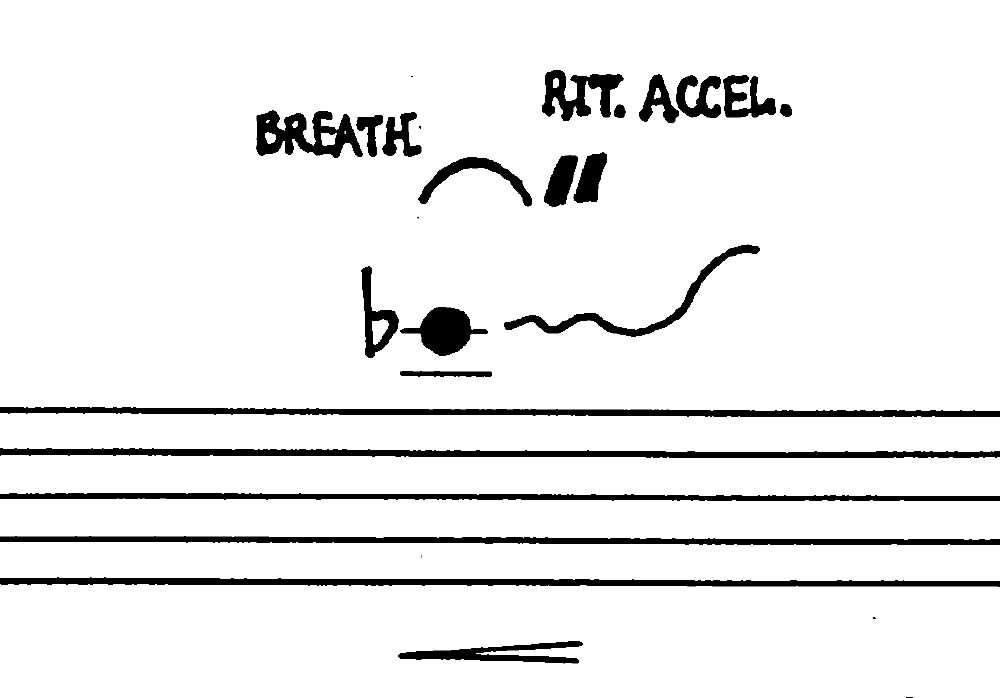
Similarly, double and triple tonguing are used in all of the woodwind and brass parts, apart from the Solo for Clarinet. Each part includes an additional specification, with the wording usually varying slightly from part to part. The Solo for Sliding Trombone states: ‘[W]hen preceded or followed by a curve, preceded or followed by a sustained tone.’ There is an example of this on page 174 (line 1). Digby discusses the challenges of this in interview. As in the Solo for Clarinet, Cage provides indications for tonguing, but in this case he is more specific, with T being combined with ‘hard’ or ‘soft’ to indicate the degree of tongue action. He also specifies ‘breathy attack’, which is unique to the trombone part. Digby interpreted this indication to mean starting the note by breathing into it rather than using the tongue to create a crisp start.
Pitch
Sliding tones and microtonal slides
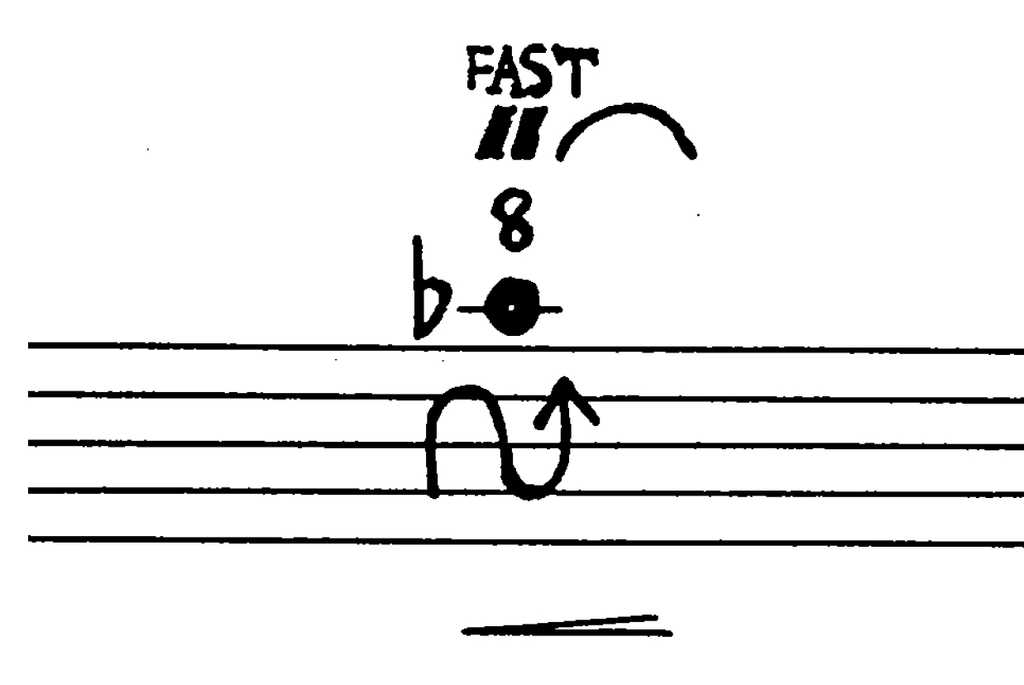
Sliding tones are a common feature of the instrumental parts. Cage writes: ‘Curves following notes are sliding tones (gliss.)’. The trombone part is the only brass part not to include the additional sentence about time-length.
Cage provides the following instruction: for microtonal slides: ‘Arrows going up or down or down and up are smaller (microtonal) slides’, but unlike some of the other woodwind and brass parts, he doesn’t suggest how the microtonal slides should be produced (i.e., in the case of the clarinet or trumpet, by using the lip). Cage seems to capitalise on the trombone’s mechanism being particularly well-suited to playing glissandi. Indeed, the trombone part is the only one to include tilde-shaped arrows for the microtonal slides (i.e., up-down-up) rather than just up-down or down-up (e.g., p. 176, line 3).
Vibrato
Each of the brass parts has a slightly different instruction for the use of vibrato. In the trombone part, Cage writes: ‘All tones are to be played with vibrato (slide or lip or slide and lip) unless accompanied by the indication ‘N.V.’ Slide vibrato is more closely associated with jazz and big band music (Svoboda & Roth, 2017, 72). Dempster (1979) describes in detail the effect of playing lip and slide vibrato together.
Other techniques
‘Spit valve open’
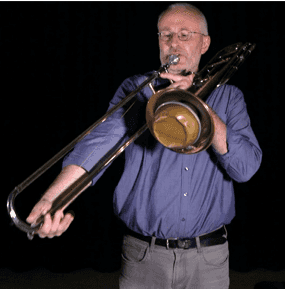
The ‘Spit valve open’ technique is used in all of the brass parts. Opening the spit valve, or water key, destabilises the sound, particularly if water has accumulated beneath the key. The strength of the sound will vary depending on the pitch of the sound and the amount of water under the key. The trombone part is the only one to include the additional instruction, ‘used only on overtone series of B flat’. This is because the water key is operated by the right hand.
Noises
Like all of the instrumental parts, Cage suggests noises to be played where stemmed notes below the stave are indicated, but also suggests that the player may choose their own noises. The trombone part is the only one to include the instruction: ‘These [noises] are verbally indicated but may be exchanged for other noise elements chosen by the player’.
Extremely high sounds (above E flat)
While Cage indicates specific extreme pitches throughout the trombone part either as part of a sliding tone, or as a single note in its own right (for example, the E♭5 on the second line of p. 175, or the B♭0 on the bottom line of p. 181), he also instructs the player to use ‘Extremely high sounds (above E flat)’ as a noise sound. This instruction is unique to the trombone part, and, Digby commented, this instruction is indicative of the extent to which trombone technique has developed and the range of the instrument has been extended over the past sixty years, and so what Rehak might have considered to be an extremely high sound is no longer quite so extreme. Indeed, Svoboda and Roth’s The Techniques of Trombone Playing (2017) lists several pieces that exceed the range of the Solo for Sliding Trombone, e.g., Xenakis’ Keren (1986) includes a G♭5 and Rihm’s Jagden und Formen (2008) uses a B♭5.
Overtone rips, or interval sounds
The instruction for ‘rips’ appears in all of the brass parts, but while the trombone part includes the word ‘overtone’, it omits the additional explanatory comment ‘rapid overtone series up or down or both’, which is provided in the trumpet and the tuba parts. In contrast to Cage’s instructions, Svoboda and Roth (2017) suggest that the gesture should descend only. Digby interpreted the instruction in line with Cage’s instructions, taking it to mean moving up or down very quickly through the overtone series.
The instruction for ‘interval sounds’ appears in both the flute and trombone parts (although the flute part includes the word ‘unpredictable’). Like flautist Nancy Ruffer, Digby understood this instruction to require some sort of multiphonic sound. It’s interesting to note that neither ‘rip’ nor ‘interval sounds’ is written in the part itself (whereas ‘rip’ is indicated in the tuba part, and ‘interval’ is indicated in the flute part), and these two techniques don’t seem to be used very often in the available recordings.
Conch shell
The trombone part is the only one to include a suggestion to use an ‘auxiliary conch shell’, but it doesn’t seem to have been used much in practice, and many players seem to take up Cage’s suggestion to exchange this sound for other ‘noise elements’ (see below). Digby described two possible ways that a conch could be used, either as a ‘wind instrument’ in its own right, or as a mute, but he didn’t use one for this performance, for ecological and practical reasons.
Mouthpiece
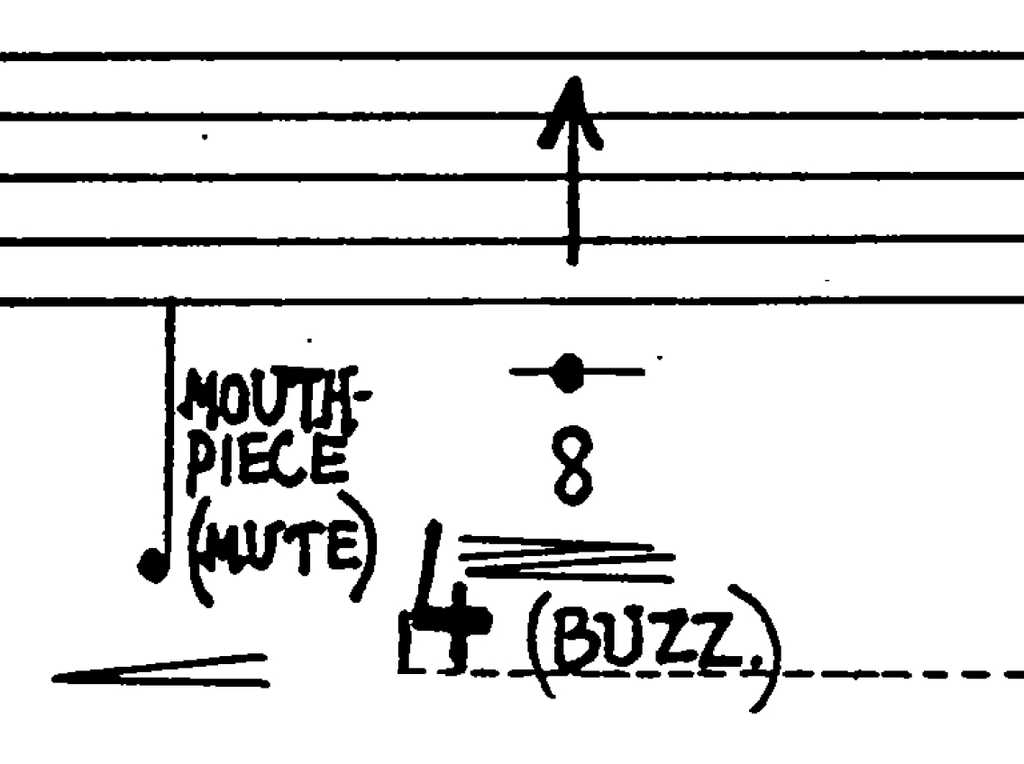
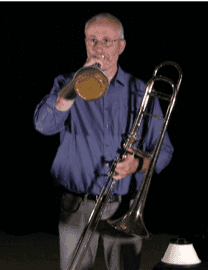
Like all of the woodwind and brass parts, the trombone part includes mouthpiece sounds, but with the additional instruction that the mouthpiece can be used ‘with or without bell apart from rest of instrument’. There are some events that require the mouthpiece to be played with a mute, e.g., p. 175, line 3. Digby interpreted this to mean that the mouthpiece is blown into the narrow end of the mute at a range of pitches, using it as a bell-like extension to the mouthpiece (pictured). Taking a different approach, Lindberg leaves the mute in the bell and uses the mouthpiece to blow into the hole of the Wah-Wah mute.
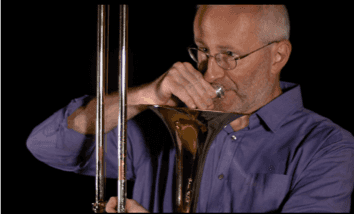
Digby interpreted the ‘with bell’ instruction to mean playing into the opening of the bell, using it as an amplifier-like device. Lindberg also takes this approach in his performance.
Dempster suggests a similar approach to Digby , but remarks that the technique ‘could also mean to remove the bell section and insert the mouthpiece, as described above, for the ram’s horn effect’ (Dempster, 1979, 49).
Shouting, speaking or barking into the instrument
All of the brass parts include the instruction to shout or bark into or through the instrument, but the trombone part also includes the suggestion of ‘speaking’. Dempster describes the ‘(dog) bark’ as one of his ‘favourite’ sounds, and suggests that while it first appears in the Concert, it is also used in Oliveros’ Theatre Piece (1965) and Ernst Krenek’s Five Pieces for trombone and piano op. 198 (1967). He comments that ‘These vocal animal sounds are not difficult and they have a long tradition in didjeridu [sic] playing’ (Dempster, 1979, 40–41). As well as shouting (both away from the instrument and into its bell), Lindberg makes a dog bark sound away from the instrument. Digby chose to make a barking-like ‘shout’ through the mouthpiece.
Other noise elements
Players have used several other sounds (often to replace the ‘conch shell’ instruction). James Fulkerson is recorded as saying that he would usually use a tenor saxophone mouthpiece instead of a conch shell (Chilton, 2007, 62) and Lindberg uses various alternative sounds, such as screaming, mouth pops, and laughing. Digby used a series of differently pitched harmonicas, as can be seen in the video of him performing p. 181.
Dismantling the instrument
The trombone part is the only part not to include bar lines, which in the other parts indicate a change of instrument or reed (as in the case of the other wind parts) or a change in scordatura (as in the case of the string parts). However, Cage provides instructions to dismantle the instrument in various ways throughout the piece: ‘Where the indications are made to play without bell, or without bell into jar, with tuning slide out or slide disconnected, make the action, not necessarily producing the pitch notated, but attempting to make simply a sound of that general range’. This means that while these actions may result in a change in sound quality of the sound to which they are applied, but the actions can also serve as theatrical gestures in their own right, at times being used in combination with several other actions, and at others being used on their own. Trombonist William Lang commented that ‘The visual “sounds” as well as the sounds of physically dismantling the instrument are some of the greatest keys to the work itself’. Each modification is addressed individually below.
‘without bell, or without bell into jar’
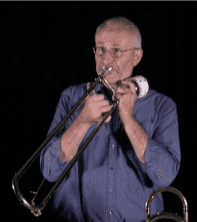
Svoboda and Roth (2017, 62) credit Cage as the first to use this technique beyond its being just a ‘gag’. Playing on the slide without a bell destabilises certain frequencies, resulting in a change of sound quality for some pitches. For the ‘into jar’ technique, both Digby (pictured) and Lindberg remove the bell and replace it with a jar with a large opening over the open tube, which acts as a resonator. The performance practice for this technique has also been shaped by its oral history: Dempster mentions putting water in the jar sometimes (in addition to the effect being noted in the reviews of the 1966 performance above, it was also possibly used in the 1964 Tudorfest performance of the Concert: Morton Subotnick recalls Dempster making a gargling sound, much to Cage’s dismay). Svoboda and Roth (2017, 130) attribute the effect to Jack Teagarden’s ‘Water Glass Trick’, which ‘was supposedly used by jazz trombonist Jack Teagarden because of its similarity to the sound of the human voice. The sound of playing on the slide alone […] is focused slightly by the water in the glass’.
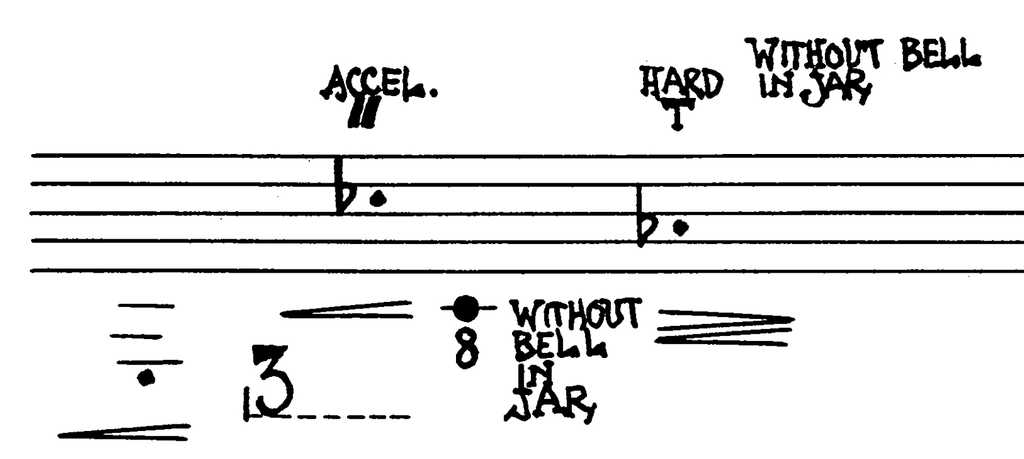
Rehak was familiar with Teagarden’s playing (Everett, 1987) so it’s likely that this is where the technique originates from. Sometimes the effect appears independently without a sound (e.g., p. 183, line 4). Digby treated this as an independent gesture, dismantling the instrument after playing the E1, putting the jar over the open tubing, and then reassembling it before playing the C♭3.
‘with tuning slide out or slide disconnected’
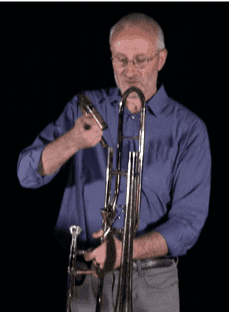
Removing the tuning slide from the instrument means that the sound doesn’t reach the bell of the instrument, which results in a more muted sound. As Digby commented, replacing the tuning slide is quite challenging to perform quickly and smoothly. Dempster writes that the advantage of this technique is that ‘because of the normal slide still in use, the tube length can be extended. The result is therefore easier to control, because it is almost a full-length trombone without bell. Time must be allowed, […] for removing and replacing the tuning slide, however’ (1979, 49).
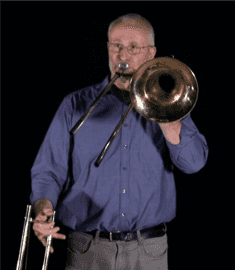
‘Slide disconnected’ suggests either detaching the main slide from the bottom tube, or removing it from the instrument completely. Playing with the slide disconnected has the strongest effect. It reduces the flexibility of pitch considerably and affects the sound quality (but the player can still adjust the pitch with the embouchure).
With both of these techniques Cage only provides the instruction to remove the slides, which creates some potential ambiguity in terms of when the standard instrumental configuration should be returned to. Equally, sometimes the way the slide instructions are written on the page seems to suggest that they’re an effect in their own right, for example, on p. 173 line 5, ‘tuning slide out’ is positioned at quite a distance from the subsequent flutter tongue B3.
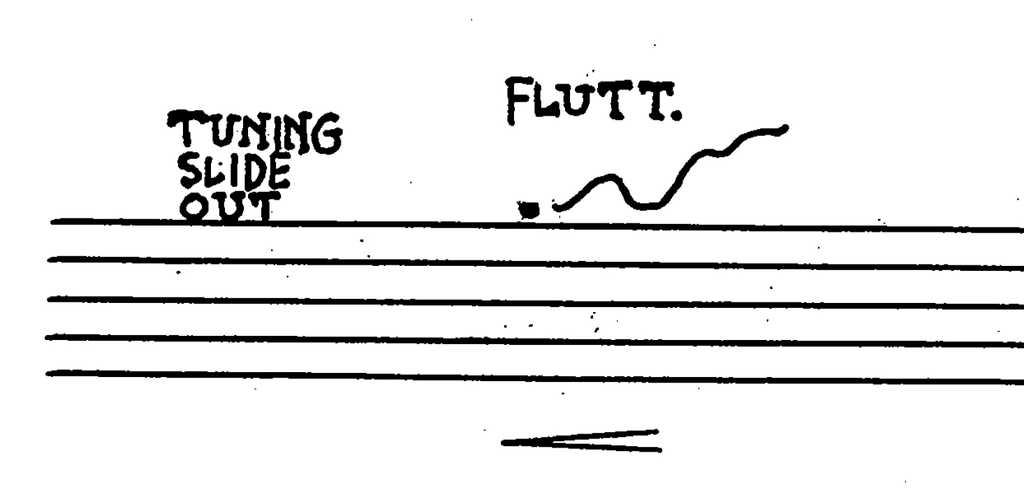
Digby would perform this as an independent gesture, putting the slide back in before playing the B3. Other players (Lindberg and Lang) attach the technique to the closest single sound. Digby was also influenced by the way in which the text was written: he suggested that the length of the text on the page might have a space-time relationship to the page (i.e., where the indication took up more horizontal space, it could last longer).
Combining techniques
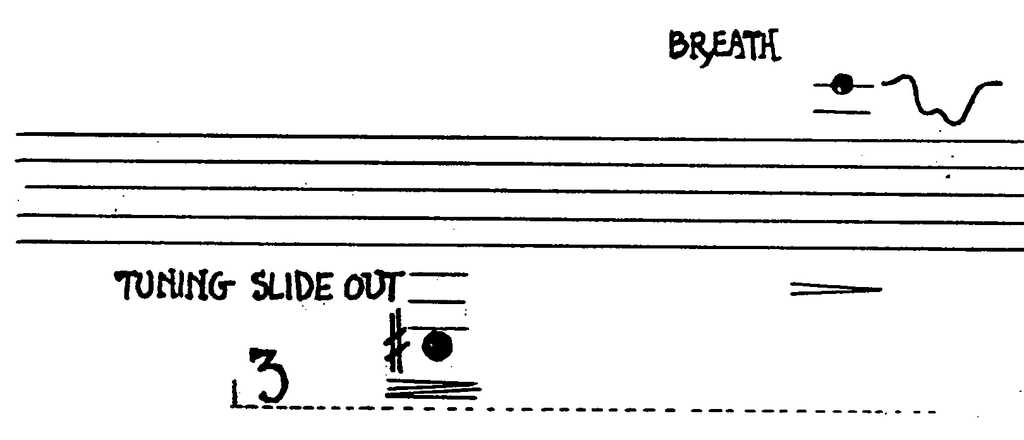
One of the most striking features of the trombone part is the way in which several actions are combined, often in a way that requires particularly challenging choreography from the trombonist. Indeed, Gillespie chose to use a spare bell in his recording, to facilitate some of the dismantling techniques (quoted in Chilton, 2007, 59). Other combinations might seem redundant or perverse. For example, on line 2 of p. 173 Cage indicates ‘tuning slide out’ with mute #3 on a G♯2. Since the removed tuning slide disconnects the bell from the instrument, the mute has no audible effect.
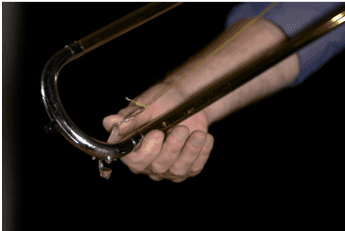
Similarly, some of the microtonal slides are combined with an open water key (e.g., p. 175, line 5) which limits the amplitude of the slide as the arm must remain in first position. Digby solved this problem by attaching a piece of string to the water key, enabling him to activate it in any position. Lang suggests two other possible solutions: ‘One is interpreting the note in treble clef as a B5, and using the lips to follow the graphic notation. Another is to use the lips over partials while interpreting the pitch in bass, tenor, or alto clef. In this way you don’t need to move out of first position.’
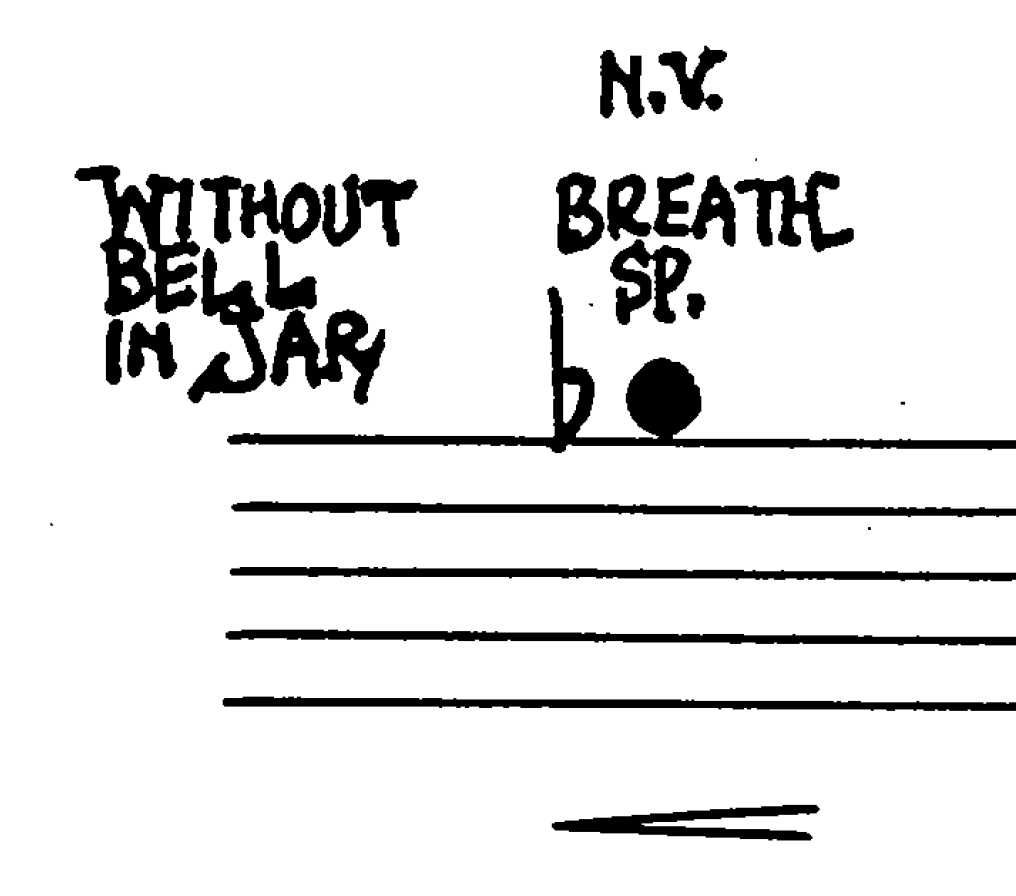
Another complex combination is used on p. 184, line 4: a non-vibrato B♭3 is combined with ‘spit valve open’ and ‘without bell in jar’. Lang was quite pragmatic about this combination: ‘One way to approach this is that there are too many sounds in the piece to give a full performance that lasts less than an hour or more. Therefore omitting some sounds is standard, as well as Cage-approved. Another way to interpret this is to place the bell on the non-playing side of the slide and hold the spit valve open simultaneously while anchoring the mouthpiece to the embouchure. Tricky, but manageable!’. A similar approach is suggested by Chilton (2007, 40).
While isolating each technique in the Solos enables a better understanding of the range and detail of techniques Cage used, the real character of each part is revealed in the ways various ways that these techniques are combined. Often one technique may affect another, make another inaudible, or combine with others to create unpredictable and unstable sounds. Performers must constantly navigate the range of options available to them in these cases and make choices as to what, and how, to prioritise in the execution of each sound. Digby discusses and demonstrates his approach to different combinations of techniques in interview.
Acknowledgements
With thanks to William Lang for sharing with the research team his experiences of performing the Solo for Sliding Trombone.
Bibliography
James Gregory Chilton, Non-intentional Performance Practice in John Cage’s Solo for Sliding Trombone (unpublished DMA thesis, University of British Columbia, 2007)
Stuart Dempster, The Modern Trombone: A Definition of its Idioms (Berkeley and Los Angeles, CA: University of California Press, 1979)
Tom Everett, ‘An Interview with Frank Rehak’, International Trombone Association Journal, vol. 15, no. 2 (Spring, 1987), 36–45
Christian Lindberg, Christian Lindberg: The Total Musician [DVD] (BIS DVD-1678, 2008)
Frank Rehak, ‘A Call from Cage’, YLEM, vol. 18, no. 10 (1998), 4
Mike Svoboda and Michel Roth, The Techniques of Trombone Playing (Kassel: Bärenreiter, 2017)
Discography
A Walk on the Wild Side: Perpetual Horizons. Bob Gillespie, trombone (South African Broadcasting Corporation, 2001)
Da Lontano. Mike Svoboda, trombone (Wergo, WER6744-2, 2012)
Music for Trombone. James Fulkerson, trombone (Etcetera KTC 1137, 1992)
The Solitary Trombone. Christian Lindberg, trombone (BIS, BISCD388, 1989)
The works of John Cage are the copyright of Henmar Press Inc., New York and are reproduced by permission of Peters Edition Limited, London. All rights reserved.
